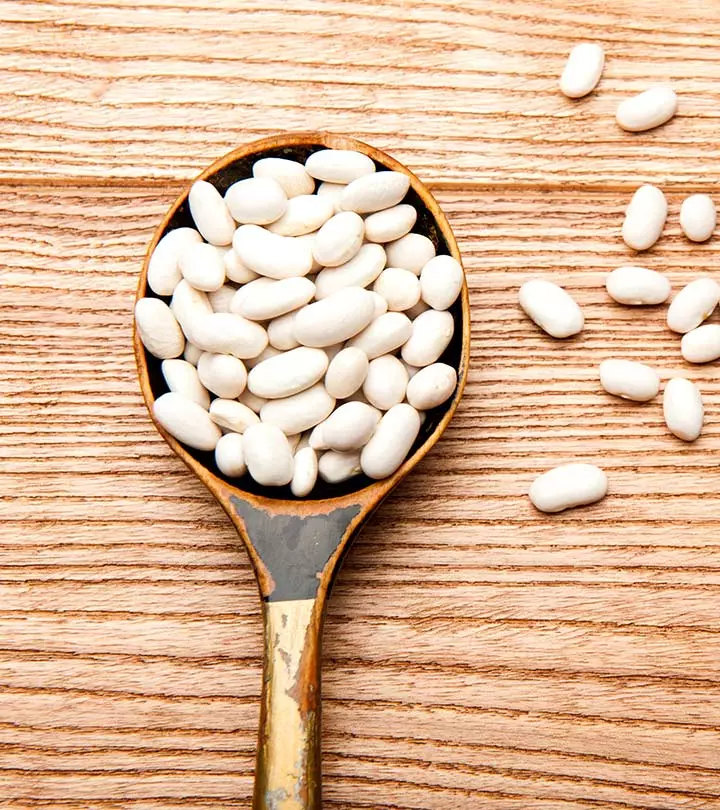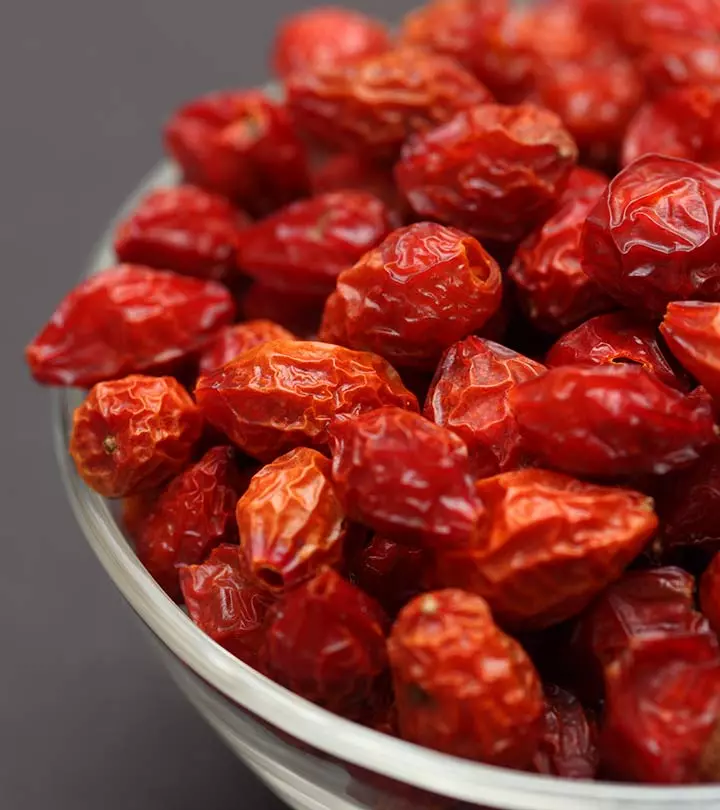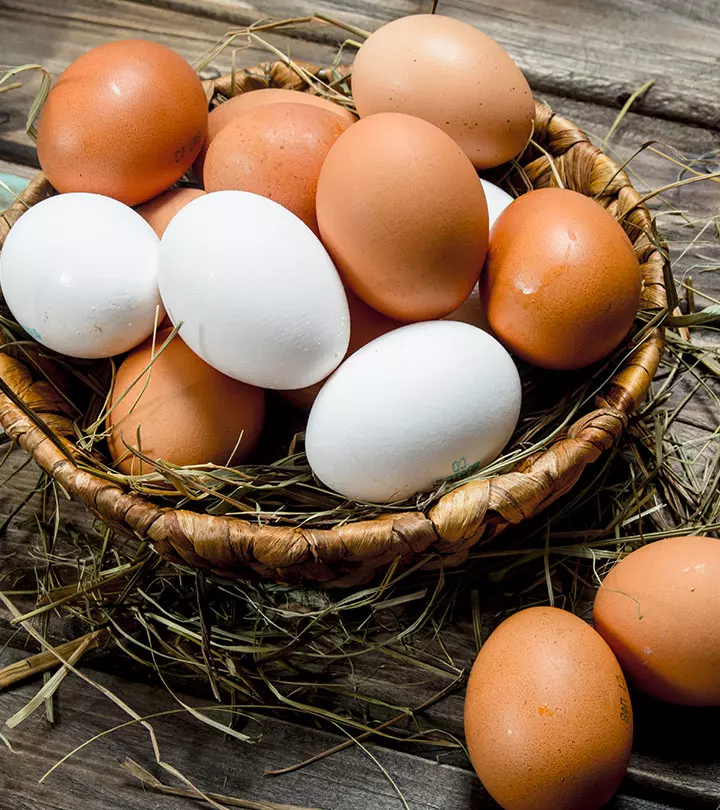Cannellini Beans: Uses, Benefits, And Cooking Tips
From soup to salad, these beans steal the show and elevate your culinary game.

Image: Shutterstock
Cannellini beans are widely consumed and are usually boiled, fried, and blanched. Like other beans, cannellini beans are nutrient-dense. The benefits of cannellini beans can be attributed to the beneficial nutrients. These beans are mostly grown in Central and Northern Italy and are mostly used in bean stew, pasta, and other popular Italian cuisines. Keep reading to know more about cannellini beans and how you can add them to your meal. Scroll down.
In This Article
What Are Cannellini Beans?
Cannellini beans, like other beans, belong to the haricot (legume) family. They are white in color and have a shape similar to kidney beans. When cooked, these beans develop a fluffy texture and have a mild nutty flavor. These beans are known to be a rich and inexpensive source of nutrients and are a part of the staple diet in many European countries. Asia and North America are now seeing a rise in demand for these beans as well.
 Fun fact
Fun factLet us now look at some of the nutritional values of cannellini beans.
Key Takeaways
- Cannellini beans are a decent source of plant protein. They are nutrient-dense and rich in fiber.
- Cannellini beans improve heart and digestive health and aid in maintaining a healthy body weight.
- Some may experience gas and bloating after consuming cannellini beans.
Cannellini Beans – Nutrition Profile
Cannellini beans are a rich source of micro and macronutrients. They contain essential minerals, proteins, carbohydrates, and dietary fiber that are good for your health. According to the US Department of Agriculture, 100 g of cannellini beans contain (1):
Nutritional Table (1)
| Name | Amount Per 100g | Value |
|---|---|---|
| Energy | 85 | kcal |
| Protein | 6.15 | g |
| Total Fat | 0 | g |
| Carbohydrates | 146.62 | g |
| Dietary fiber | 3.8 | g |
| Total Sugars | 0.77 | g |
| Calcium | 46 | mg |
| Iron | 2.77 | mg |
| Sodium | 69 | mg |
| Vitamin C | 0 | mg |
| Vitamin A | 0 | mg |
| Trans Fat | 0 | g |
| Cholesterol | 0 | mg |
Now, let us now look at some of the health benefits of cannellini beans.
Health Benefits Of Cannellini Beans
When it comes to maintaining a healthy lifestyle, your diet is just as important as your workout regimen. A balanced diet should consist of a healthy mix of fruits, vegetables, whole grains, legumes, and lean meats (2). Legumes, such as cannellini beans, are a good source of plant-based protein (1). Research has shown that the benefits of kidney beans are plenty, especially white kidney beans/Cannellini beans. This is especially beneficial if you follow a plant-based diet or vegan diet. Let us look at some of the health benefits cannellini beans have to offer:
1. May Improve Digestive Health
Cannellini beans are high in fiber (1). Dietary fiber helps in improving your bowel movements and overall digestive health (2), (3).
Additionally, fiber breaks down into short-chain fatty acids, which may improve your metabolism and intestinal health (4).
According to the 2022 Food and Health Survey conducted on 1,005 Americans, 35% of individuals consumed beans to enhance digestive or gut health. Additionally, 36% seeking weight loss or management included beans, peas, or lentils in their diet.
2. May Help Maintain Healthy Body Weight
Cannellini beans are low in calories and high in fiber and protein, which keep you feeling full for longer (1). This makes them the ideal food to include in your diet to maintain healthy body weight.
In general, people who consume beans have been found to have lower body weight and smaller waist sizes compared to people who don’t eat beans. They are also at a reduced risk of increased waist size and obesity (5).
3. May Improve Heart Health
Bean consumers have been found to have lower systolic blood pressure compared to non-consumers (5). Some studies have also found that cannellini beans reduce both systolic and diastolic blood pressures, though more research is required to prove this (6).
Consuming cannellini beans, also known as white kidney beans, may also help in reducing LDL cholesterol and blood glucose levels (6).
4. May Help Fight Cancer
Cannellini beans may have the potential to fight against cancerous cells. Research has shown that white kidney beans have proteins called lectin that have an anti-proliferative effect on certain cancer cells. This means it does not allow cancer cells to multiply and spread throughout the body. Further, it adds that lectin also induces apoptosis (programmed cell death) by following an extrinsic (outside the body of the cell) pathway (7). However, this effect was not found to be uniform across all types of cancer cells, and further scientific evidence is needed for any conclusive claims regarding the anti-cancer properties of cannellini beans.
Cannellini beans are not only a nutritious addition to your diet but also an environmentally conscious choice. As plant-based foods, they require significantly fewer resources to produce compared to animal protein sources. This lower environmental impact translates to a reduced carbon footprint.
Cultivating beans is a proactive step towards improving soil health and reducing the need for synthetic fertilizers and pesticides. By incorporating more plant-based proteins into your diet, you are contributing to a more sustainable and environmentally friendly food system and taking responsibility for the health of our planet.
Now that you have learned about the health benefits of cannellini beans, let us look at how to identify, choose, and store cannellini beans.
How To Choose And Store Cannellini Beans
Have you ever come across a recipe that requires white beans, and you were left scratching your brains as to which white beans to use? After all, there are many beans that are called white beans. For instance, cannellini beans, navy beans, Great Northern beans, and baby lima beans are all referred to as white beans.
Here’s how you can identify cannellini beans: Among all the white beans, cannellini beans are the largest in size. They are shaped like a kidney and are also called white kidney beans. These beans have a nutty and earthy flavor with a soft texture.
Storing cannellini beans is no rocket science. Just put them in an airtight jar and store them away in a clean, cool, and dry place in your kitchen or storeroom. These beans, when kept in these conditions, are perfectly good to use for a period of 2 years.
Now, let us find out how you can add these beans to your diet.
How To Include Cannellini Beans In Your Diet
Given how cannellini beans are rich in protein and fiber, adding them to your diet is fairly simple. You can add them to your salads, soups, and a whole bunch of other dishes. Here are a few quick and easy recipes that you can try out.
Simple And Easy Cannellini Soup
This is a refreshing and healthy soup that you can make in 20 minutes.
Ingredients
- 1 cup of cannellini beans
- 1 onion, chopped
- 1 carrot, chopped
- 1 celery, chopped
- 1 potato, diced
- 2 leaves of spinach (optional)
- Tomato paste
- 1½ cups of vegetable stock (homemade or store-bought)
- ½ cup of white wine
- Rosemary
- 2-3 teaspoons of olive oil
- Salt and pepper for seasoning
Preparation
- Sautethe onions, carrots, and celery in olive oil for about 5 minutes.
- Add the cannellini beans, garlic, tomato paste, rosemary, and a bit of salt and pepper for seasoning.
- Stir these well for a minute.
- Add the wine and toss all the vegetables. Stir on simmer till the wine evaporates.
- Add the vegetable stock and spinach and cook the vegetables till you feel the potatoes are soft.
- Check the seasoning and add more if needed.
- Serve the soup in a bowl. Garnish by drizzling some olive oil on top. Enjoy it with a side of your favorite bread.
 Pro tip
Pro tipAnother easy recipe you can try is stir-fried cannellini beans.
Stir-fried Cannellini Beans
Ingredients
- 1 can of cannellini beans
- 2-3 tablespoons of olive oil
- Italian seasoning
- 4-5 chives
- Salt and pepper for seasoning
Preparation
- Rinse and drain the cannellini beans.
- In a skillet or pan, heat up olive oil.
- Add the beans along with the Italian seasoning to the pan and cook for 2 minutes on medium heat. Stir occasionally.
- Garnish with fresh chives and serve.
A blogger shares a delightful recipe for slow-cooked cannellini beans and herbs. Expressing a deep love for beans, the blogger reminisces about a childhood dish. “I love beans. Always have, always will. When my Nonno & Nonna would come out to California to visit us they would make for me a mix of beans, vegetables and tuna to have on hot summer days (i).”
Now that you’ve understood how to incorporate cannellini beans into your diet, let us understand if there are any possible side effects of eating these beans.
Side Effects Of Cannellini Beans
Cannellini beans, and beans of any kind, are some of the healthiest foods available to us. They are inexpensive and easily available in most parts of the world. There are no known serious side effects of eating cannellini beans. However, you may feel mild intestinal discomfort after eating these beans.
Gas and bloating are the two biggest side effects of eating cannellini beans. This is because of the high fiber content of these beans. This fiber contains compounds like oligosaccharides, resistant starch, inulin, guar gum, and pectin that produce moderate to high amounts of gas (8). To reduce this effect, increase your intake of beans slowly, starting with a small amount.
The benefits of cannellini beans are numerous. These can be attributed to its beneficial nutrients. The dietary fiber in these beans aids in improving digestive health. In addition, these beans are low in calories and rich in fiber and protein, and they aid in weight management. They also lower blood pressure and improve heart health. Cannellini beans can be easily added to soups, salads, and many other dishes. Although the consumption of cannellini beans is generally safe, excess intake may cause gas and bloating. Hence, moderate consumption is advised to reap its benefits.
Frequently Asked Questions
Are cannellini beans a Superfood?
Yes. Cannellini beans are a nutrient-dense food, packed with protein, carbohydrates, dietary fiber, and minerals that help boost overall health.
Are cannellini beans anti-inflammatory?
No. Studies have shown that cannellini beans may help reduce inflammation in the colon (9).
Do cannellini beans contain omega-3?
Yes. Beans (Phaseolus vulgaris L.), in general, are a good source of omega-3 and omega-6 polyunsaturated fatty acids (10).
Are cannellini beans high in potassium?
Yes. Cannellini beans contain about 230 mg potassium in every 100 g serving (11).
What is the difference between chickpeas and cannellini beans?
Chickpeas are yellower, creamier, and starchier than cannellini beans.
Discover the amazing health benefits of cannellini beans. Watch this video and learn the many health benefits of beans, from promoting heart health to aiding digestion.
Personal Experience: Source
StyleCraze's articles are interwoven with authentic personal narratives that provide depth and resonance to our content. Below are the sources of the personal accounts referenced in this article.
(i) Slow Cooked Cannellini Beans & Herbshttps://jurisepicurus.com/2014/04/24/cannellinibeans/
References
Articles on StyleCraze are backed by verified information from peer-reviewed and academic research papers, reputed organizations, research institutions, and medical associations to ensure accuracy and relevance. Read our editorial policy to learn more.
- Cannellini Beans
https://fdc.nal.usda.gov/fdc-app.html#/food-details/551175/nutrients - Essentials of Healthy Eating: A Guide
https://www.ncbi.nlm.nih.gov/labs/pmc/articles/PMC3471136/ - The Health Benefits of Dietary Fibre
https://www.ncbi.nlm.nih.gov/labs/pmc/articles/PMC7589116/ - The Role of Short-Chain Fatty Acids in The Interplay Between Diet, Gut Microbiota, and Host Energy Metabolism
https://www.ncbi.nlm.nih.gov/labs/pmc/articles/PMC3735932/ - Bean Consumption Is Associated With Greater Nutrient Intake, Reduced Systolic Blood Pressure, Lower Body Weight, and A Smaller Waist Circumference in Adults: Results From The National Health and Nutrition Examination Survey 1999-2002
https://pubmed.ncbi.nlm.nih.gov/18845707/ - It’s No Has Bean: A Review of the Effects of White Kidney Bean Extract on Body Composition and Metabolic Health
https://www.ncbi.nlm.nih.gov/labs/pmc/articles/PMC7284421/ - Inhibitory Effects Of Pulse Bioactive Compounds On Cancer Development Pathways
https://www.ncbi.nlm.nih.gov/pmc/articles/PMC6163461/ - Effects of High-Fiber Diets and Macronutrient Substitution on Bloating: Findings From the OmniHeart Trial
https://www.ncbi.nlm.nih.gov/labs/pmc/articles/PMC7056053/ - White and Dark Kidney Beans Reduce Colonic Mucosal Damage and Inflammation In Response to Dextran Sodium Sulfate
https://pubmed.ncbi.nlm.nih.gov/25841250/ - Fatty acid profile of Romanian’s common bean (Phaseolus vulgaris L.) lipid fractions and their complexation ability by β-cyclodextrin
https://www.ncbi.nlm.nih.gov/pmc/articles/PMC6874339/ - Nutritional Composition and Bioactive Content of Legumes: Characterization of Pulses Frequently Consumed in France and Effect of the Cooking Method
https://www.ncbi.nlm.nih.gov/pmc/articles/PMC6266829/
Read full bio of Jennifer House
Read full bio of Varsha Patnaik
Read full bio of Ravi Teja Tadimalla
Read full bio of Payal Karnik



























Community Experiences
Join the conversation and become a part of our empowering community! Share your stories, experiences, and insights to connect with other beauty, lifestyle, and health enthusiasts.